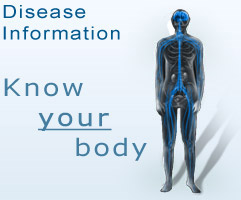Pemphigus vulgaris
What is pemphigus vulgaris?
Pemphigus vulgaris is a rare auto-immune condition that causes severe blistering of the skin and mucous membranes lining the mouth, nose, throat and genitals. The blisters have thin roofs that break easily, leaving raw areas (erosions) that can be extensive and painful. Pemphigus vulgaris does not heal by itself and always requires treatment by a specialist.
What causes pemphigus vulgaris?
Our immune system (our body's defence mechanism against illness) produces antibodies needed to fight off infections. Normally, these antibodies do not attack our own bodies. However, with auto-immune conditions, the immune system ‘mistakenly' fights our own body instead. In the case of pemphigus vulgaris, the immune system mistakenly views the cells in our skin and mucous membranes as ‘foreign', and produces antibodies that damage them. Antibodies that attack parts of our own body are called ‘auto-antibodies'.
The auto-antibodies in pemphigus vulgaris target proteins called desmogleins, which are present on the cells in the outer layer of the skin (the epidermis). Desmogleins act as a glue to stick these cells together, but when the auto-antibodies formed in pemphigus vulgaris combine with the desmogleins, the cells in the skin and mucous membranes no longer stick together properly and fall apart. This causes the blisters and erosions that are typical of pemphigus vulgaris.
Although it is known that antibodies to desmoglein cause pemphigus vulgaris, it is still not clear why some people develop these auto-antibodies at all.
Pemphigus vulgaris affects both sexes equally. It can start at any age but is most common in middle-aged adults. It affects people of all races but is more common in some (for example, people of Jewish origin) than others.
Pemphigus vulgaris is not an infection; it cannot be caught or passed on to anyone else.
Is pemphigus vulgaris hereditary?
Strictly speaking no, as it does not pass from generation to generation. Genetic factors are important, but other factors are needed to trigger pemphigus vulgaris into activity.
What are the symptoms of pemphigus vulgaris?
The raw, unhealing erosions are painful and can disturb sleep. Erosions in the mouth can interfere with eating and drinking, leading to loss of weight.
What does pemphigus vulgaris look like?
In most patients, the blisters and erosions first appear in the mouth and later on the skin. However, some patients never or rarely get blisters or erosions on their skin.
The skin:
- The skin lesions start as thin-walled blisters (collections of clear fluid within the skin), arising on a background of normal-looking skin. Because they are so fragile, pemphigus vulgaris blisters break very easily, leaving raw areas known as erosions.
- Erosions are areas of skin (or mucous membrane), which lack its top (outer) layer. They look raw and feel sore, like a burn. Erosions can join together to create larger areas of raw skin that look as if the top layer has been scraped off. They can become crusty and scabbed, leaving discoloured marks on the skin when they heal.
The mouth:
Intact blisters are seldom seen in the mouth in pemphigus vulgaris because they get broken so easily. Erosions are seen there instead. There may be just one or two, or several that can join together.
Will pemphigus vulgaris clear by itself?
No, the condition will not clear without treatment. There will be times when it flares up, and others when it gets better. There is no way of knowing when these flare-ups will occur or how bad they will be. However, pemphigus vulgaris can be controlled by long-term treatment and may eventually heal completely, so that it does not flare up when treatment stops.
How is pemphigus vulgaris diagnosed?
- Pemphigus vulgaris is rare and most general practitioners have never seen it. Your own doctor will refer you to a dermatologist or an oral medicine specialist, who will make a provisional diagnosis of pemphigus vulgaris on the basis of the changes seen on your skin and in your mouth.
- Thereafter, a biopsy will be taken. This is a sample of an unbroken blister which is processed in the laboratory and then examined under the microscope.
- The diagnosis of pemphigus vulgaris will be confirmed by finding cells in the epidermis that are rounding off and separating from each other.
- As further confirmation of the diagnosis, part of the biopsy specimen is likely to be examined by a technique known as direct immunofluorescence to demonstrate the presence of pemphigus vulgaris auto-antibodies in the skin.
- Another useful test is to measure the levels of pemphigus vulgaris auto-antibodies in the blood. This is done by indirect immunofluorescence and is sometimes called an antibody titre test. It is a useful way of monitoring how active the pemphigus vulgaris is, and the results can suggest changes in treatment.
How is pemphigus vulgaris treated?
General aims
Treatment is important because pemphigus vulgaris can be serious. Treatment of the condition entails using medicines that are usually taken orally but are sometimes given into a vein through a drip. As pemphigus vulgaris is an auto-immune condition, most treatments work by suppressing the immune system. The initial aim of treatment is ‘disease control', i.e. to prevent new blisters from forming and to heal the existing ones. It usually takes about two to three weeks to stop new blisters coming up, and sometimes as long as six to eight weeks for healing to be complete. Once control has been achieved, the dose of the medication will be reduced slowly to the lowest dosage needed to keep the pemphigus vulgaris under control. Treatment usually starts with a corticosteroid, which may later be combined with a so-called ‘steroid-sparing' drug.
Corticosteroids
Pemphigus vulgaris is usually treated with a corticosteroid first. This is effective and works more quickly than most of the other treatments. The corticosteroids used are synthetic versions of a natural hormone produced in smaller quantities by the body. They work by suppressing the immune system. High doses of the corticosteroid, usually prednisolone, are given to bring the pemphigus vulgaris under control. The dose is then reduced slowly to minimise side effects. However, the prednisolone can seldom be stopped completely and most patients need a small maintenance dose to keep their condition under control. This dose varies from person to person, and depends partly on their weight.
Steroid-sparing and adjuvant drugs
Although they are very effective, corticosteroids unfortunately do have side effects. For this reason, other medications are often used as well. These are known as steroid-sparing drugs or adjuvant drugs, and work well when combined with corticosteroids. They include:
1. Immunosuppressives: azathioprine, cyclophosphamide, mycophenolate mofetil and ciclosporin.
2. Additional drugs: gold, methotrexate, tetracyclines (minocycline or doxycycline) combined with nicotinamide and dapsone.
Side effects
Since all these medications can have serious side effects, patients must be monitored carefully by regular urine and blood tests, as well as blood pressure readings.
What can I do?
- Consult your doctor if you are thinking about ceasing to take your corticosteroids, as it is dangerous to do so suddenly.
- If you have erosions in your mouth it may be sensible to avoid eating heavily-spiced or hard-textured foods.
References
HARMAN KE, ALBERT S AND BLACK MM. 2003. Guidelines for the management of pemphigus vulgaris. British Journal of Dermatology.149: 926 - 937.
Links to other Internet sites:
www.pemphigus.org/ (International Pemphigus Foundation)
www.dermnetnz.org/dna.pemphigus/pgus.html
 TransmedBanner4.jpg)

